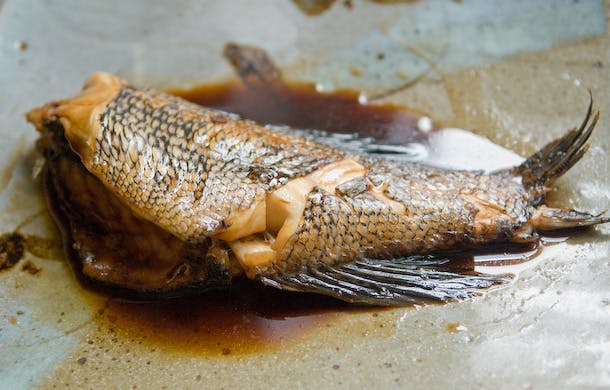
Seabass Simmered in Sake and Soy Sauce
Learn how to make a traditional Japanese sea bass dish simmered in sake, soy sauce, and sugar. This recipe is simple yet flavorful, resulting in perfectly cooked and tender fish. Follow the technique and tips for a delicious dining experience.
Chef Atsushi Nakahigashi used only soy sauce, sake and sugar to simmer the fish in this recipe. Japanese recipe books usually say to add ginger, too, to cut the fishiness. "But you don't need it," Atsushi said. "Ginger is too strong and will overpower the fish's flavor. In keeping with Nakahigashi's natural style, Atsushi explained that the soy sauce itself is enough to temper any fishiness. By the way, this technique works well with carp and sea bream, too.
Sea Bass Simmered in Soy Sauce and Sake
Ingredients:
- 1 whole sea bass
- Koikuchi soy sauce (dark soy sauce)
- Sake
- Sugar
Instructions:
-
Prepare the Sea Bass:
- Place the whole sea bass in a large pot.
-
Season the Fish:
- Sprinkle about 1 to 1.5 tablespoons of sugar over the fish.
- Pour approximately 1 cup of sake and 1 cup of soy sauce over the fish, ensuring equal amounts of sake and soy sauce. The liquid should be about half an inch deep, not covering the entire fish.
-
Cooking Process:
- Create a loose-fitting aluminum otoshibuta (foil lid) to cover the fish and cooking liquid.
- Turn the heat to high until the liquid starts boiling, then reduce to medium and simmer.
-
Adjust the Flavor:
- After about 5 minutes, taste the liquid. If the soy sauce flavor is too strong, add another tablespoon of sugar to achieve a balance between saltiness and sweetness.
-
Finish Cooking:
- After approximately 10 minutes, when the sea bass is ready, turn off the heat.
- Tilt the pot at an angle and spoon the cooking liquid over the whole fish several times to ensure the fish is infused with the flavors of the cooking liquid.
-
Serve:
- Transfer the sea bass to a serving plate and pour the remaining cooking liquid over it.
- To eat, press down the center of the fish with chopsticks, split it open along the spine, and enjoy the tender flesh dipped in the cooking liquid.
Techniques and Their Purposes:
- Equal Parts Sake and Soy Sauce: Creates a rich, umami-packed cooking liquid that infuses the fish with a complex flavor.
- Loose-Fitting Otoshibuta: Allows steam to circulate and flavors to infuse evenly while preventing the fish from drying out.
- Basting with Cooking Liquid: Ensures the top part of the fish, not submerged in the liquid, also absorbs the savory sweetness of the sauce.
- Adjusting Flavors: Tasting and adjusting the cooking liquid ensures the perfect balance between the savory depth of soy sauce and the subtle sweetness of sake and sugar.
